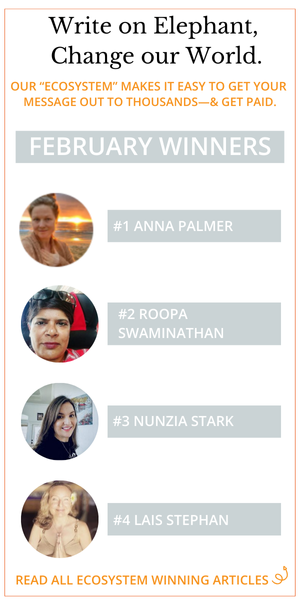View this post on Instagram
Believing depression was my genetic destiny, I spent years battling feelings of sadness.
These mini-cyclones of hopelessness were self-fulfilling, as I was good at proving to myself that life just wasn’t going my way.
During one of these energetic lulls, my therapist asked me about my self-care habits: “Are you drinking alcohol? Are you getting adequate sleep, nutrition, and hydration? Are you exercising and meditating?”
An advocate for personal responsibility, I was faced with the possibility that my daily, habitual choices play a strong role in defining my emotional state. I toyed with the idea of sinking into my determined, pouty two-year-old self to convince her that my feelings were really out of my control and I would not be entertaining any other academic or otherwise ridiculous notions.
As I momentarily paused to consider how I would respond to Dr. C’s inquiry, visions of the smiling, bright-eyed, and open-faced Buddhist monks I met on a recent meditation retreat passed through my consciousness. At these gatherings, they encouraged self-care activities and served nutrient-dense food with plenty of non-alcoholic fluids. I brushed this off, telling myself this was probably part of the minimalistic vibe and not necessarily in therapeutic support of the participant’s emotional health.
But then, I remembered my younger brother, Joe. On a recent visit to his cozy home nestled in the fresh green pines of North Carolina, I would find him each morning contently in his kitchen making a smoothie with just-picked farmers market berries, locally made yogurt, and sweet honey. He had just invested in a new, industrial-looking blender. The concoction had the bright reddish orange hues of a sunset, and it tasted like health, happiness, and serenity.
Still feeling the need to remain in my discomfort to prove myself right, I mentally noted that he had not been inflicted with the same genetic downer genes. Worry and sadness had never had a substantial presence in his emotional repertoire, as it had in mine.
I had not previously made the association between Joe’s liquid breakfast bliss and my feelings of peace while visiting him. However, I was feeling called into action by my therapist’s words. I armed myself with a clunky, professional-looking blender and committed myself to a smoothie a day.
Following the Vitamix guidelines, I obediently layered my ingredients: water, nuts, creamy yogurt, dark leafy greens, tangy fresh fruits. My initial instinct was to greedily add every beautiful piece of plump produce that excited me.
The radiant dollops of color—sunny yellow mango, crimson raspberries, and the tiny, cute polka dots of chia seeds danced together in the cool, thick glass jar until it transformed into a festive, pink, homogenous blend. It looked like a proudly presented frozen cocktail I might order at a thatched roof tiki bar on a warm, summer vacation night. It tasted pretty good, too.
Filled to my eyeballs in creamed fiber and vitamins, I would eventually learn to taper my enthusiasm to a more appropriate volume. Concocting a variety of richly colored blends, I started to look forward to my daily experiment of self-care. I even felt a bit sneaky, as if I was cheating my way into health by gulping down my five daily recommended fruits and vegetables without hours of preparation and chewing.
After a month of this routine, I became convinced that I felt better. The heavy emotional pack which dug into my shoulders and relentlessly made every step forward more difficult had become a bit lighter.
Was it placebo effect or something else that had me happily hooked? I started to do a little snooping and found loads of nutritional information.
Legitimate scientific works included an article published about dietary recommendations to prevent depression. This article suggested that eating a diet with fruits, nuts, seeds, omega-3 fatty acids, and vegetables could help prevent depression.
A second scholarly article promoted a nutrient profiling system to guide dietary recommendations for mental health. The 12-star nutrients in these foods were folate, iron, long chain omega-3 fatty acids, magnesium, potassium, selenium, thiamine, vitamin A, vitamins B-6 and B-12, vitamin C, and zinc.
Some of my go-to ingredients were acting in much the same way as designer drugs do to increase serotonin and dopamine levels in the brain. Elevated levels of these neurotransmitters stabilize mood and give a feeling of well-being.
Here are some of my favorite examples of important nutrients, along with some examples of foods we can find them in:
Omega-3 fatty acids (walnuts, avocados)
Folate (leafy greens)
Zinc (almonds, oatmeal, pumpkin seeds)
Folic acid (bananas, avocados, blueberries, raspberries, strawberries)
Potassium (avocados, bananas)
Selenium (Brazil nuts)
Folate (spinach, citrus fruits, kiwis)
Vitamin B6 (mangos)
Tryptophan (chia seeds, yogurt, spinach, kiwis)
Tyrosine (bananas, avocados, almonds)
Flavonoids (dark chocolate/cocoa nibs, tea, apples, citrus fruits, blueberries)
Carotenoids (carrots)
Drinking a smoothie each day is part of my new empowering daily regiment. My reliance on therapy sessions has decreased, and I now prioritize a routine of exercise, meditation, adequate sleep, and nutrition.
Certain foods can function as natural antidepressants, and they can be incorporated into a smoothie as a delicious and powerful start to the day.
~

 Share on bsky
Share on bsky






Read 4 comments and reply